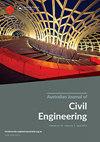Fatigue behaviour of conventional and rubber-modified gap-graded asphalt mixtures using bending and axial fatigue tests
IF 1.6
Q3 ENGINEERING, CIVIL
引用次数: 0
Abstract
ABSTRACT The study presented in this paper assesses and compares the laboratory fatigue performance of two gap-graded asphalt concrete (AC) mixture: one using crumb rubber (CR) (rubber-modified) and without using CR (conventional). The rubber-modified and conventional gap-graded mixtures were sampled from the E18 highway located in the Stockholm area of Sweden. The testing program consisted of dynamic modulus, |E*|, bending beam, and axial fatigue tests. The |E*| master curves of the respective AC mixtures and their generalised fatigue model coefficients (k 1, k 2, k 3) from the axial fatigue tests were used to predict and compare the long-term pavement performance of each mixture using the AASHTOWare Pavement ME Design software. This analysis was performed systematically using parametric variations to assess the sensitivity of the predicted performance to individual material factors. Fatigue test results from both bending beam and axial fatigue tests showed clear evidence of improved fatigue behaviour for the rubber-modified gap-graded mixture compared to the conventional gap-graded mixture. The Pavement ME design analysis showed that the rubber-modified gap-graded mixture outperformed the conventional mixture. The parametric sensitivity analysis showed that this improved behaviour was the result of an increase in k 1 and decrease in k 2 of the fatigue life relationships at individual test temperatures of the rubber-modified gap-graded mixture. It was also found that the |E*| and the fatigue coefficient k 3 of the rubber-modified gap-graded mixture has an adverse impact on its fatigue performance compared to that of the conventional gap-graded mixture.使用弯曲和轴向疲劳试验研究常规和橡胶改性间隙级配沥青混合料的疲劳特性
摘要本文评估并比较了两种间隙级配沥青混凝土(AC)混合料的实验室疲劳性能:一种是使用橡胶屑(CR)(橡胶改性),另一种是不使用CR(常规)。橡胶改性和传统间隙级配混合物是从位于瑞典斯德哥尔摩地区的E18公路上取样的。测试程序包括动态模量、|E*|、弯曲梁和轴向疲劳测试。使用AASHTOWare路面ME设计软件,使用各自AC混合料的|E*|主曲线及其来自轴向疲劳试验的广义疲劳模型系数(k1,k2,k3)来预测和比较每种混合料的长期路面性能。该分析是使用参数变化系统地进行的,以评估预测性能对单个材料因素的敏感性。弯曲梁和轴向疲劳试验的疲劳试验结果表明,与传统间隙级配混合物相比,橡胶改性间隙级配混合物的疲劳性能得到了改善。路面ME设计分析表明,橡胶改性间隙级配混合料的性能优于传统混合料。参数敏感性分析表明,这种改善的行为是橡胶改性间隙级配混合物在单个试验温度下疲劳寿命关系的k1增加和k2减少的结果。研究还发现,与传统间隙级配混合物相比,橡胶改性间隙级配混合物的|E*|和疲劳系数k3对其疲劳性能有不利影响。
本文章由计算机程序翻译,如有差异,请以英文原文为准。
求助全文
约1分钟内获得全文
求助全文

 求助内容:
求助内容: 应助结果提醒方式:
应助结果提醒方式:


